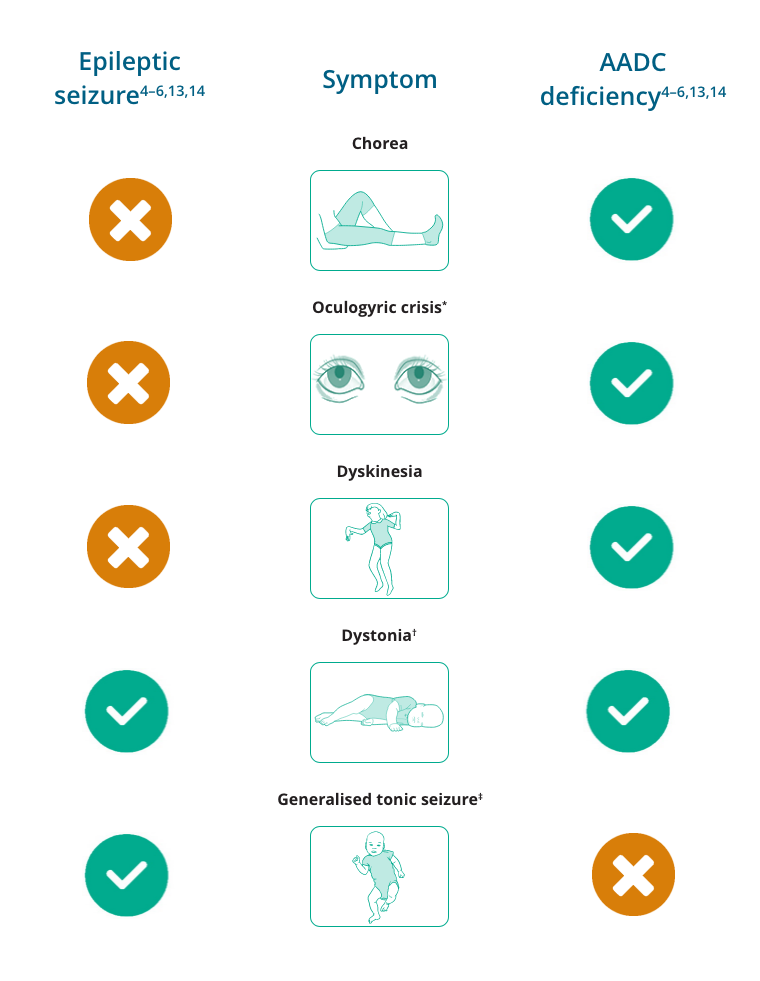What is epilepsy?
- Epilepsy is a chronic neurological disorder characterised by recurrent seizures due to abnormal excessive or synchronous neuronal activity in the brain1,2
- It is one of the most common neurological diseases in the world, affecting around 50 million people of all ages2
Classification of epilepsy
Epileptic seizures are divided into three categories:3
Generalised seizures
- Generalised seizures begin in bilateral, distributed neuronal networks and are comprised of absence, generalised tonic-clonic (GTC), myoclonic, and atonic subtypes
Focal seizures
- Focal seizures originate in neuronal networks limited to part of one cerebral hemisphere. The clinical manifestations depend on the area of cortex involved
Epileptic spasms
- Epileptic spasms are characterised by sudden extension or flexion of extremities that are held for several seconds and then recur in clusters
Overlapping and differentiating symptoms of epilepsy and AADC deficiency
- Paroxysmal events that often develop in patients with AADC deficiency, such as oculogyric crises, tonic or dystonic posturing of the limbs, myoclonus and chorea, can appear similar to epileptic seizures and, consequently, can be identified as such4–8
- As a result, patients with AADC deficiency may receive multiple antiepileptic drug treatments without response before receiving a diagnosis of AADC deficiency8
- True epileptic seizures are uncommon in patients with AADC deficiency,5 although a few cases have been reported4,9–12
- Based on the limited number of case reports, epileptic seizures tend to occur in the first few years of life, are not severe, are of the GTC or complex focal subtype and, where documented, have been well controlled with administration of conventional antiepileptic drugs4,9–12
Overlapping and differentiating symptoms of epileptic seizures and AADC deficiency:

*Oculogyric crises have been reported to be present in 97% (n=30/31) of patients with AADC deficiency aged 2–12 years.13
†Dystonia may, uncommonly, appear as a sign of rare epileptic disorders.14
‡Generalised tonic seizures are not typically seen in AADC deficiency, but have been reported in a small number of patients with AADC deficiency who have also been diagnosed with epilepsy.6
Workup of patients with symptoms of epilepsy
- The differentiation of epileptic seizures from non-epileptic paroxysmal events using electroencephalogram (EEG) analysis is critical to ensure an accurate diagnosis of AADC deficiency in patients with symptoms of epilepsy, and to ensure the appropriate management of patients4
- EEG findings tend to differ between patients with AADC deficiency and patients with epilepsy, and an ictal EEG analysis is key for differentiating between patients experiencing paroxysmal events and patients with epilepsy4
AADC, aromatic L-amino acid decarboxylase; EEG, electroencephalogram; GTC, generalised tonic-clonic.
- Fischer RS, et al. Epilepsia. 2017;58(4):520–530.
- World Health Organization. Epilepsy: a public health imperative. 2019. Available from: https://www.who.int/mental_health/neurology/epilepsy/report_2019/en/. Accessed April 2022.
- Stafstrom CE, Carmant L. Cold Spring Harb Perspect Med. 2015;5:a022426.
- Ito S, et al. Dev Med Child Neurol. 2008;50:876–878.
- Wassenberg T, et al. Orphanet J Rare Dis. 2017;12:12.
- Pons R, et al. Neurology. 2004;62:1058–1065.
- Brun L, et al. Neurology. 2010;75:64–71.
- Lee WT. Epilepsy & Seizure. 2010;3:147–153.
- Swoboda KJ, et al. Ann Neurol. 2003;54(Suppl 6):S49–S55.
- Hsieh H-J, et al. Eur J Nucl Med Mol Imaging. 2005;32:517.
- Anselm IA, Darras BT. Pediatr Neurol. 2006;35(2):142–144.
- Manegold C et al. J Inherit Metab Dis. 2009;32:371–380.
- Pearson T, et al. J Inherit Metab Dis. 2020;43:1121–1130.
- Orphanet. Progressive myoclonic epilepsy with dystonia. Available from: https://www.orpha.net/consor/cgi-bin/OC_Exp.php?Expert=352596&lng=EN. Accessed April 2022.
Explore interactive clinical case studies
